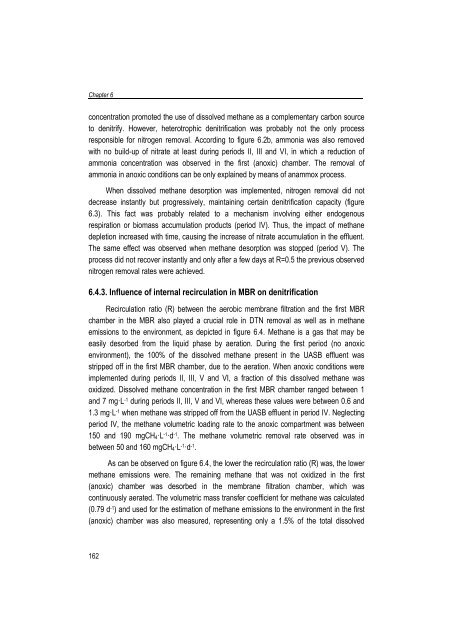Combining submerged membrane technology with anaerobic and ...
Combining submerged membrane technology with anaerobic and ...
Combining submerged membrane technology with anaerobic and ...
Create successful ePaper yourself
Turn your PDF publications into a flip-book with our unique Google optimized e-Paper software.
Chapter 6concentration promoted the use of dissolved methane as a complementary carbon sourceto denitrify. However, heterotrophic denitrification was probably not the only processresponsible for nitrogen removal. According to figure 6.2b, ammonia was also removed<strong>with</strong> no build-up of nitrate at least during periods II, III <strong>and</strong> VI, in which a reduction ofammonia concentration was observed in the first (anoxic) chamber. The removal ofammonia in anoxic conditions can be only explained by means of anammox process.When dissolved methane desorption was implemented, nitrogen removal did notdecrease instantly but progressively, maintaining certain denitrification capacity (figure6.3). This fact was probably related to a mechanism involving either endogenousrespiration or biomass accumulation products (period IV). Thus, the impact of methanedepletion increased <strong>with</strong> time, causing the increase of nitrate accumulation in the effluent.The same effect was observed when methane desorption was stopped (period V). Theprocess did not recover instantly <strong>and</strong> only after a few days at R=0.5 the previous observednitrogen removal rates were achieved.6.4.3. Influence of internal recirculation in MBR on denitrificationRecirculation ratio (R) between the aerobic <strong>membrane</strong> filtration <strong>and</strong> the first MBRchamber in the MBR also played a crucial role in DTN removal as well as in methaneemissions to the environment, as depicted in figure 6.4. Methane is a gas that may beeasily desorbed from the liquid phase by aeration. During the first period (no anoxicenvironment), the 100% of the dissolved methane present in the UASB effluent wasstripped off in the first MBR chamber, due to the aeration. When anoxic conditions wereimplemented during periods II, III, V <strong>and</strong> VI, a fraction of this dissolved methane wasoxidized. Dissolved methane concentration in the first MBR chamber ranged between 1<strong>and</strong> 7 mg·L -1 during periods II, III, V <strong>and</strong> VI, whereas these values were between 0.6 <strong>and</strong>1.3 mg·L -1 when methane was stripped off from the UASB effluent in period IV. Neglectingperiod IV, the methane volumetric loading rate to the anoxic compartment was between150 <strong>and</strong> 190 mgCH 4·L -1·d -1 . The methane volumetric removal rate observed was inbetween 50 <strong>and</strong> 160 mgCH 4·L -1·d -1 .As can be observed on figure 6.4, the lower the recirculation ratio (R) was, the lowermethane emissions were. The remaining methane that was not oxidized in the first(anoxic) chamber was desorbed in the <strong>membrane</strong> filtration chamber, which wascontinuously aerated. The volumetric mass transfer coefficient for methane was calculated(0.79 d -1 ) <strong>and</strong> used for the estimation of methane emissions to the environment in the first(anoxic) chamber was also measured, representing only a 1.5% of the total dissolved162
















